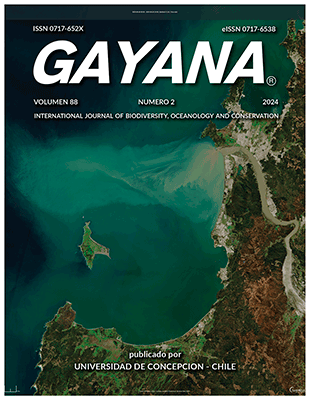Abstract
Biodiversity in coastal environments is affected by anthropogenic activities and climate change, altering community structures, biogeochemical cycles, and ecosystem functioning. The ecological status of the Gulf of Arauco was determined based on soft bottom benthic macrofauna during three oceanographically contrasting periods (spring 2021, summer and winter 2022). Seven biotic indexes were estimated (Shannon- Wiener diversity, Warwick, AMBI, M-AMBI, Bentix, BOPA, and BPA), and their relationships with sediment physicochemical variables were analyzed. The community was mainly composed of polychaetes (>80%), followed by crustaceans and mollusks. Seasonally, the biotic index showed significant variations, except for the Shannon-Wiener diversity index and the M-AMBI. Ecological status fluctuated from “moderately disturbed” and “good” for all indexes, except in the Bentix index, which classified the environment as “poor” or “seriously disturbed”, levels which were also observed in various spatial faunal assemblages identified in the study area. A significant association was detected between the AMBI, Bentix, BOPA, and BPA indexes with redox potential, total organic carbon (TOC), and percentages of sand and silt, whereas the M-AMBI, Warwick, and Shannon-Wiener diversity indexes were not associated with environmental variables. This study is the first to estimate and compare different biotic indexes of benthic macrofauna in subtidal coastal environments in the Humboldt Current System using a multivariate approach. We suggest an integrated use, towards contributing to the development of an ecosystem approach to managing highly productive and anthropized coastal environments.

This work is licensed under a Creative Commons Attribution-NonCommercial 4.0 International License.
Copyright (c) 2024 Patricio Torres-Ramírez, Rodrigo Veas, M. Cristina Krautz, Cristian Chandía, Marco Salamanca, Aldo Hernández, Sergio Contreras, Eduardo Hernández-Miranda

